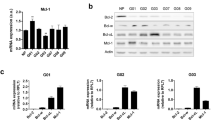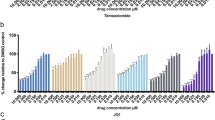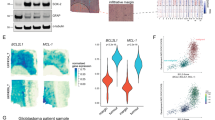Abstract
Specific activation of apoptosis in tumor cells offers a promising approach for cancer therapy. Induction of apoptosis leads to activation of specific proteases. Two major pathways for caspase activation in mammalian cells have been described. One apoptotic pathway involves members of the tumor necrosis factor family of cytokine receptors (eg death receptor 5 (DR5)). The other pathway is controlled by the Bcl-2 family of proteins. The purpose of this study was to investigate whether increased apoptosis occurs in human glioma cells following infection with a recombinant adenoviral vector encoding the human Bax gene under the control of human vascular endothelial growth factor (VEGF) promoter element (AdVEGFBax) in combination with an anti-human DR5 monoclonal antibody (TRA-8). Specific overexpression of exogenous Bax protein induced apoptosis and cell death in glioma cell lines, through activation of both caspase-8 and -9, leading to activation of downstream caspase-3. The relative sensitivity to AdVEGFBax for the glioma cell lines was U251MG>U373MG>U87MG>D54MG. The recently characterized TRA-8 monoclonal antibody induces apoptosis of most TRAIL-sensitive tumor cells by specific binding to DR5 receptors on the cellular membrane. TRA-8 induced rapid apoptosis and cell death in glioma cells, but did not demonstrate detectable cytotoxicity of primary normal human astrocytes. The efficiency of TRA-8-induced apoptosis was variable in different glioma cell lines. The relative sensitivity to TRA-8 was U373MG>U87MG>U251MG>D54MG. The combination of TRA-8 treatment and overexpression of Bax overcame TRA-8 resistance of glioma cells in vitro. Cell viability of U251MG cells was 71.1% for TRA-8 (100 ng/ml) alone, 75.9% for AdVEGFBax (5 MOI) alone and 41.1% for their combination as measured by MTS assay. Similar enhanced apoptosis results were obtained for the other glioma cell lines. In vivo studies demonstrated that the combined treatment significantly (P<0.05) suppressed the growth of U251MG xenografts and produced 60% complete tumor regressions without recurrence. These data suggest that the combination of TRA-8 treatment with specific overexpression of Bax using AdVEGFBax may be an effective approach for the treatment of human malignant gliomas.
This is a preview of subscription content, access via your institution
Access options
Subscribe to this journal
Receive 12 print issues and online access
$259.00 per year
only $21.58 per issue
Buy this article
- Purchase on Springer Link
- Instant access to full article PDF
Prices may be subject to local taxes which are calculated during checkout






Similar content being viewed by others
References
Reed JC . Mechanisms of apoptosis. Am J Pathol 2000; 157: 1415–1430.
Gross A, McDonnell J, Korsmeyer S . BCL-2 family members and the mitochondria in apoptosis. Genes Dev 1999; 13: 1899–1911.
Kagawa S et al. Antitumor effect of adenovirus-mediated Bax gene transfer on p53-sensitive and p53-resistant cancer lines. Cancer Res 2000; 60: 1157–1161.
Xiang J et al. Pro-apoptotic treatment with an adenovirus encoding Bax enhances the effect of chemotherapy in ovarian cancer. J Gene Med 2000; 2: 97–106.
Bodmer JL et al. TRAIL receptor-2 signals apoptosis through FADD and caspase-8. Nat Cell Biol 2000; 4: 241–243.
Ashkenazi A et al. Safety and antitumor activity of recombinant soluble Apo2 ligand. J Clin Invest 1999; 104: 155–162.
Walczak H et al. Tumoricidal activity of tumor necrosis factor-related apoptosis-inducing ligand in vivo. Nat Med 1999; 5: 157–163.
Ichikawa K et al. Tumoricidal activity of a novel anti-human DR5 monoclonal antibody without hepatocyte cytotoxicity. Nat Med 2001; 8: 954–960.
Kaliberov S et al. Adenovirus-mediated transfer of BAX driven by the vascular endothelial growth factor promoter induces apoptosis in lung cancer cells. Mol Ther 2002; 6: 190–198.
Van Engeland M et al. A novel assay to measure loss of plasma membrane asymmetry during apoptosis of adherent cells in culture. Cytometry 1996; 24: 131–139.
Yung WK . New approaches to molecular therapy of brain tumors. Curr Opin Neurol 1994; 7: 501–505.
Shinoura N et al. Adenovirus-mediated transfer of bax with caspase-8 controlled by myelin basic protein promoter exerts an enhanced cytotoxic effect in gliomas. Cancer Gene Ther 2000; 7: 739–748.
Lowe SL et al. Prostate-specific expression of Bax delivered by an adenoviral vector induces apoptosis in LNCaP prostate cancer cells. Gene Therapy 2001; 8: 1363–1371.
Folkman J . What is the evidence that tumors are angiogenesis dependent? J Natl Cancer Inst 1990; 82: 4–6.
Arbisher JL et al. Oncogenic H-ras stimulates tumor angiogenesis by two distinct pathways. Proc Natl Acad Sci USA 1997; 94: 861–866.
Grugel S et al. Both v-Ha-Ras and v-Raf stimulate expression of the vascular endothelial growth factor in NIH 3T3 cells. J Biol Chem 1995; 270: 25915–25919.
Mukhopadhyay D, Tsiokas L, Sukhatme VP . Wild-type p53 and v-Src exert opposing influences on human vascular endothelial growth factor gene expression. Cancer Res 1995; 55: 6161–6165.
Kieser A et al. Mutant p53 potentiates protein kinase C induction of vascular endothelial growth factor expression. Oncogene 1994; 9: 963–969.
Fukumura D et al. Hypoxia and acidosis independently up-regulate vascular endothelial growth factor transcription in brain tumors in vivo. Cancer Res 2001; 61: 6020–6024.
Plate KH, Risau W . Angiogenesis in malignant gliomas. Glia 1995; 15: 339–347.
Takekawa Y, Sawada T . Vascular endothelial growth factor and neovascularization in astrocytic tumors. Pathol Int 1998; 48: 109–114.
Park WS et al. Inactivating mutations of KILLER/DR5 gene in gastric cancers. Gastroenterology 2001; 121: 219–225.
Irmler M et al. Inhibition of death receptor signals by cellular FLIP. Nature 1997; 388: 190–195.
Hopkins-Donaldson S et al. Loss of caspase-8 expression in neuroblastoma is related to malignancy and resistance to TRAIL-induced apoptosis. Med Pediatr Oncol 2000; 35: 608–611.
Eggert A et al. Resistance to tumor necrosis factor-related apoptosis-inducing ligand (TRAIL)-induced apoptosis in neuroblastoma cells correlates with a loss of caspase-8 expression. Cancer Res 2001; 61: 1314–1319.
Burns TF, El-Deiry WS . Identification of inhibitors of TRAIL-induced death (ITIDs) in the TRAIL-sensitive colon carcinoma cell line SW480 using a genetic approach. J Biol Chem 2001; 276: 37879–37886.
Lamothe B, Aggarwal BB . Ectopic expression of Bcl-2 and Bcl-xL inhibits apoptosis induced by TNF-related apoptosis-inducing ligand (TRAIL) through suppression of caspases-8, 7, and 3 and BID cleavage in human acute myelogenous leukemia cell line HL-60. J Interferon Cytokine Res 2002; 22: 269–279.
Ravi R, Bedi A . Requirement of BAX for TRAIL/Apo2L-induced apoptosis of colorectal cancers: synergism with sulindac-mediated inhibition of Bcl-x(L). Cancer Res 2002; 62: 1583–1587.
Luo X et al. Bid, a Bcl2 interacting protein, mediates cytochrome c release from mitochondria in response to activation of cell surface death receptors. Cell 1998; 94: 481–490.
Yin XM . Signal transduction mediated by Bid, a pro-death Bcl-2 family proteins, connects the death receptor and mitochondria apoptosis pathways. Cell Res 2000; 10: 161–167.
LeBlanc H et al. Tumor-cell resistance to death receptor–induced apoptosis through mutational inactivation of the proapoptotic Bcl-2 homolog Bax. Nat Med 2002; 8: 274–281.
Deng Y, Lin Y, Wu X . TRAIL-induced apoptosis requires Bax-dependent mitochondrial release of Smac/DIABLO. Genes Dev 2002; 16: 33–45.
Peter ME et al. The death receptors. Results Probl Cell Differ 1999; 23: 25–63.
Sprick MR et al. FADD/MORT1 and caspase-8 are recruited to TRAIL receptors 1 and 2 and are essential for apoptosis mediated by TRAIL receptor 2. Immunity 2000; 12: 599–609.
Zhang H et al. BAR: an apoptosis regulator at the intersection of caspases and Bcl-2 family proteins. Proc Natl Acad Sci USA 2000; 97: 2597–2602.
Stegh AH et al. Inactivation of caspase-8 on mitochondria of Bcl-xL-expressing MCF7-Fas cells: role for the bifunctional apoptosis regulator protein. J Biol Chem 2002; 277: 4351–4360.
Author information
Authors and Affiliations
Additional information
Supported by Sankyo Co., Ltd and Pediatric Brain Tumor Foundation of the United States Grant #000136268
Rights and permissions
About this article
Cite this article
Kaliberov, S., Stackhouse, M., Kaliberova, L. et al. Enhanced apoptosis following treatment with TRA-8 anti-human DR5 monoclonal antibody and overexpression of exogenous Bax in human glioma cells. Gene Ther 11, 658–667 (2004). https://doi.org/10.1038/sj.gt.3302215
Received:
Accepted:
Published:
Issue Date:
DOI: https://doi.org/10.1038/sj.gt.3302215
Keywords
This article is cited by
-
Hyperthermia Induces Endoplasmic Reticulum-Mediated Apoptosis in Melanoma and Non-Melanoma Skin Cancer Cells
Journal of Investigative Dermatology (2008)
-
DR5 Activation of Caspase-8 Induces DC Maturation and Immune Enhancement In Vivo
Molecular Therapy (2008)
-
Combination of cytosine deaminase suicide gene expression with DR5 antibody treatment increases cancer cell cytotoxicity
Cancer Gene Therapy (2006)
-
HGS-ETR1, a fully human TRAIL-receptor 1 monoclonal antibody, induces cell death in multiple tumour types in vitro and in vivo
British Journal of Cancer (2005)
-
Plattenepithelkarzinome des Kopf-Hals-Bereichs
HNO (2005)



